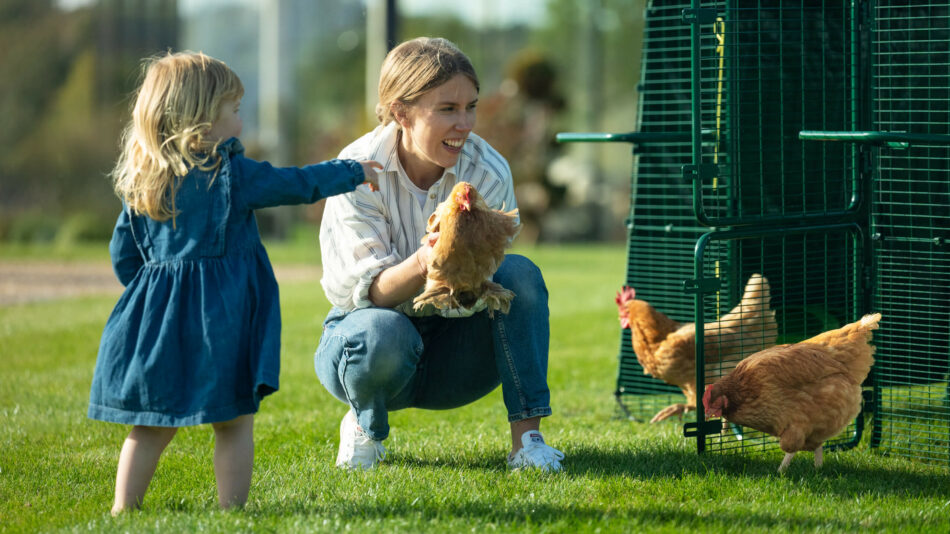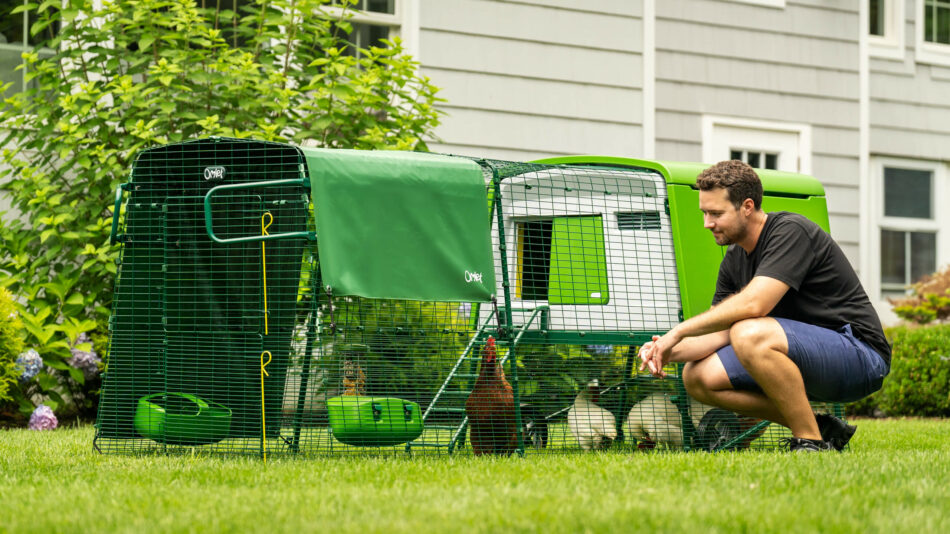Reading and influencing flock behavior
If you’ve been a chicken keeper for a while, you’re no stranger to their fascinating behaviors. But there’s more to reading and influencing flock behavior than meets the eye. Quirky personalities, squabbles at the feeder, or sudden shifts in flock dynamics are some observable chicken behaviors that are full of nuances for flock raisers to dive into. Here’s a deeper look at understanding chickens on a more advanced level — from reading subtle shifts in the pecking order in chickens to interpreting vocalizations and even mapping out your flock’s social structure.
Reading Flock Behavior: What Your Chickens Are Telling You
The better you become at reading chicken body language, the quicker you can pinpoint emerging problems, prevent bullying, and support a balanced pecking order. Think you’re already fluent in flock language? See if you recognize these expressions of chicken behavior.
Shifts to the pecking order
Every healthy flock has a hierarchy, and it’s not always fixed. While the pecking order in chickens should be stable, illness, stress, aging flock members, or the introduction of new birds can shake things up. If you have a rooster in your flock, they will more than likely take charge. But a flock full of hens will have one dominant hen take up the mantle of top-bird. Throughout this hen’s term at the top, other hens will vie for top position. Here’s what a healthy challenge to the hierarchy may look like:
- Hens briefly sparring with their hackles raised (similar to roosters).
- Chasing or pecking each other around the roosting or feeding areas.
- Increased vocalizations among 2-3 hens during any social activity like feeding, dust bathing, or drinking.
While brief upsets to the pecking order are normal and expected, there are some potential red flags to look out for:
- If a typically dominant hen starts isolating themselves or sleeping away from the rest of the flock, it may be due to illness or injury.
- Bullying away from food at every feeding time is not normal chicken behavior, and can quickly lead to lower-ranking hens not eating.
- Drawing blood, excessive feather pulling, or other injuries are more than simple pecking order disagreements.
Hens displaying this level of aggression should be separated from the flock for a time, and reintegrated slowly back into the flock once the pecking order has stabilized. In rare cases, aggressive hens may need to be rehomed to a flock with a more dominant hen.
What’s behind body language?
Chickens are constantly communicating with their bodies. Even subtle shifts in posture can reveal everything from mood shifts to health concerns. The “basics” of chicken body language still takes a practiced eye to understand, but with practice you’ll be able to recognize these in your chickens:
- Tail down: Often indicative of discomfort, illness, or egg-binding.
- Puffed-up feathers: In the absence of cold weather, this can be caused by stress, broodiness, or illness.
- Head tucked or hiding in corners: Fear or submission, usually when the pecking order is being reorganized.
- Wings slightly extended with a tense body: On alert or preparing to assert dominance. In hot weather it can also be a sign of heat stress in chickens, especially when accompanied by panting.
Vocalizations: becoming fluent in fowl
Most people think of roosters as being vocal, but as seasoned chicken keepers know, hens can be surprisingly forthcoming with audible communication. Each sound serves a specific purpose, and it takes time to familiarize yourself with them. Listen to your flock daily to become fluent in fowl language, like:
- Soft clucks: Express contentment, especially when foraging.
- Loud squawks: Distress or protest, often heard when a preferred nesting box is occupied.
- Growls or low rumbling: Warning others to back off, emitted by broody hens.
- The “egg song”: Often thought of as a celebratory call when an egg is laid, more recent research suggests that it’s an effort to lure predators away from the nest.
- High-pitched alert calls: Usually sounding like short blasts of “boks” and squawking, hens are alerting the rest of the flock to potential danger like a hawk circling or a snake approaching.
Understanding these calls (especially the alert calls) will help you react faster to threats, stress, or discomfort.
Feeding patterns and social pressure
Like cliques in a high school cafeteria, hens have their way of deciding who eats when and where. But if you see a lower ranking hen in the hierarchy being pushed away from food consistently, it’s extended beyond normal eating behavior and entered into the realm of bullying. Observing mealtimes with your chickens can be incredibly revealing for finding out where each hen currently ranks in the pecking order.
Watch for hens that each first: these will be your highest ranking hens. The hen head of the pecking order should also hang back after eating their fill to ensure that all lower ranking hens are able to eat. This will allow you to see your highest and lowest ranking hens in a matter of minutes, and will ensure that the pecking order is maintaining a healthy balance.
Broody behavior
Even beginners can recognize broody behavior from hens. This not-so-subtle display of hormonal activity entails:
- Growling
- Puffing up feathers
- Pecking or biting when the nest is approached
- Refusal to leave the nest
While broodiness is helpful in hatching eggs, a flock without a rooster doesn’t benefit from a broody hen. In fact, a hen that’s gone broody can have a ripple effect throughout the flock and cause a decrease in egg production or avoidance of the nesting area. Breaking a broody hen is advised when eggs aren’t fertile — especially in the hotter months, as a broody hen rarely leaves the nest to eat or drink.
Influencing flock behavior: strike a balance between environment and enrichment
Bored chickens fill their time with trouble. A lack of stimulation leads to feather picking, pecking order aggression, or listlessness. Try these ideas to add enrichment to your flock and see how they thrive with entertaining elements.
- A Caddi Chicken Treat Holder elevates snacktime and challenges their pecking skills.
- Dust bathing areas large enough to fit 2-3 hens at a time to support this communal activity.
- A Chicken Swing, Chicken Perches, or a PoleTree to add perching space inside the run and to add space for your flock to explore.
- Create forage piles with leaves or hay and scatter scratch grains throughout to encourage natural foraging behaviors.
Even a simple change like moving perches around or adding herbs to their existing chicken dust bath can reset social tensions.
Training chickens with treats
Have you tried training your chickens? They’re smart and intuitive animals that respond to training — if you’re speaking their language. And when it comes to chickens, food talks.
Encourage shy hens to socialize with you by offering them treats by hand. Train outgoing hens to hop into your lap by enticing them with dried mealworms or fresh kitchen scraps. You can also use positive reinforcement to help balance the pecking order by breaking up aggressive posturing between hens with a tasty treat, or rewarding them for coming when you call.
Smart coop design promotes social harmony
The layout of your chicken coop and run can greatly affect social behavior. Use strategic design to prevent stress and encourage peace among your flock. Place your coop in a quiet, shaded area to promote good roosting and egg-laying habits, and provide enough chicken feeders and waterers so that there’s plenty to go around.
Provide chicken run weather covers to keep your flock dry and shaded, and use chicken fencing to give them extra foraging space outside of their setup. And, if your space allows, opt for a mobile chicken coop to move your flock to new grass every few days to keep their enclosure and environment fresh.
Bonus tip for advanced keepers: map your flock
If you want to take your chicken keeping to the next level, try flock sisal mapping. This method of visually charting your chickens’ behavior will help you better understand their dynamics.
How to map chicken behavior:
- Observe and take notes
Watch how your chickens interact with each other over several days. Note who eats first, who gets pecked at the most, who roosts where, and how conflicts get resolved.
- Draw your flock
Don’t worry, no art degree necessary. Use circles for each hen tally marks or other indicators of who pecks who and the hens that submit. Get as creative as you’d like: create a flow chart, a graph, or if you happen to have a degree in art, make detailed sketches of each hen.
- Track over time
Update your data weekly, and keep up with it for several months. You’ll start seeing patterns emerge from seasonal shifts, illness related changes, or the impact of adding new hens.
- Apply what you learn
Use the map to rearrange perches, feeding areas, or other elements according to the pecking order, and plan introductions to new flock members strategically.
This method deepens your understanding of chickens as individual members of the flock and as a social group.
Omlet and your flock
At Omlet, we believe the more you understand your flock, the more joy and success you’ll have as their keeper. Whether you’re rethinking your chicken run or chicken coop, or looking for chicken toys or perches to add to your setup, we’ve got the chicken products that will bring you closer to your flock than ever before.
This entry was posted in Chickens



One reply on “Reading and influencing flock behavior”
Very informative